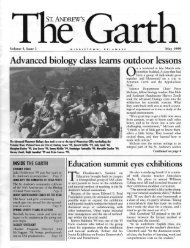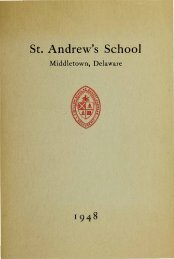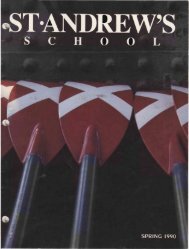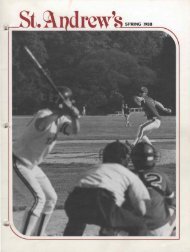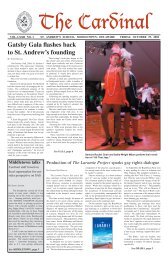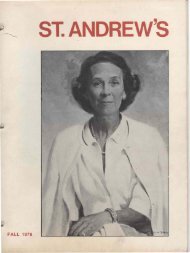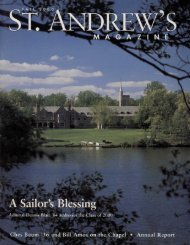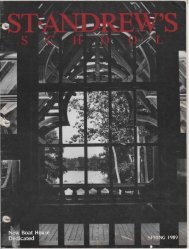Untitled - Saint Andrew's School Archive - St. Andrew's School
Untitled - Saint Andrew's School Archive - St. Andrew's School
Untitled - Saint Andrew's School Archive - St. Andrew's School
Create successful ePaper yourself
Turn your PDF publications into a flip-book with our unique Google optimized e-Paper software.
Beyond Academics<br />
Living at <strong>St</strong>. <strong>Andrew's</strong><br />
There is no doubt about it. At<br />
<strong>St</strong>. <strong>Andrew's</strong> academic pursuits<br />
occupy by far the largest portion<br />
of our time. To successfully meet<br />
the academic challenge, students<br />
must accept this reality and be<br />
willing to devote the time and<br />
effort required to meet it.<br />
But the educational process at<br />
<strong>St</strong>. <strong>Andrew's</strong> is not limited to<br />
our core curriculum, and our<br />
daily lives include moments of<br />
relaxation and fun. The following<br />
sections of our catalogue will<br />
give you a glimpse of life at<br />
<strong>St</strong>. <strong>Andrew's</strong> beyond academics.<br />
The Mid-Atlantic<br />
Coastal Plain<br />
The physical location of any<br />
school matters. Perhaps this<br />
is especially true of a boarding<br />
school.<br />
<strong>St</strong>. <strong>Andrew's</strong> is located in lower<br />
New Castle County, Delaware, 25<br />
miles south of Wilmington and approximately<br />
three miles southeast<br />
of Middletown.<br />
The countryside is typical of the<br />
rural Atlantic Coastal Plain, rich in<br />
farmland and historic associations<br />
with Colonial Delaware and Revolutionary<br />
times. One is never far<br />
from water. Tidal streams meander<br />
west to the Chesapeake Bay and<br />
east to the Delaware Bay. Lakes, of<br />
which there are many, were originally<br />
mill ponds. Silver Lake and<br />
Appoquinimink Creek border our<br />
campus to the north and east, while<br />
two-mile-long Noxontown Pond borders<br />
our southern flank. Between<br />
and around these bodies of water<br />
the <strong>School</strong> owns approximately 2,000<br />
acres, partially wooded, but mostly<br />
under cultivation.<br />
Wildlife is everywhere evident.<br />
Deer, fox, hawks, owls, quail and<br />
innumerable songbirds inhabit the<br />
central campus. Noxontown Pond<br />
and Appoquinimink Creek are homes<br />
for ducks, herons, egrets, osprey and<br />
an occasional eagle, not to mention<br />
bass which can exceed eight pounds.<br />
From September through February<br />
thousands of Canada geese, snow<br />
geese and swans descend upon the<br />
area, feeding in the corn fields and<br />
rafting at night on the safety of the<br />
water. Our Life Science Department<br />
takes full advantage of these natural<br />
resources, and students and faculty<br />
who enjoy hunting and fishing have<br />
opportunities to pursue their interests,<br />
though hunting is not permitted<br />
on <strong>School</strong> property, which is a<br />
wildlife sanctuary.<br />
The weather is also typical of the<br />
region. Fall lingers and spring comes<br />
early. Most consider these seasons<br />
to be the most beautiful times of the<br />
year. Certainly they are the most active.<br />
Swimming, sailing, canoeing<br />
and fishing on Noxontown Pond<br />
highlight most weekends. Although<br />
winters are usually short, they can<br />
be cold. We normally count on at<br />
least a week or two of ice skating<br />
and occasional blizzards to add<br />
excitement and outdoor activity to<br />
our normal routine.<br />
Though <strong>St</strong>. <strong>Andrew's</strong> is located<br />
in a rural setting of great beauty, it<br />
also lies within easy driving distance<br />
of some of our nation's most interesting<br />
cultural and historic urban<br />
areas. Trips to museums, theaters,<br />
historical sites and areas of cultural<br />
interest in Washington, D.C., Baltimore,<br />
Wilmington, Philadelphia and<br />
New York, as well as to lectures and<br />
performances at area universities<br />
occur throughout the year.<br />
Home Away from<br />
Home<br />
It is difficult to exaggerate the<br />
importance of residential life at<br />
a boarding school. Many of the<br />
most valuable "lessons" our<br />
students learn are taught through<br />
the interaction they have with their<br />
peers and faculty during unscheduled<br />
moments on the corridors.<br />
The social structure of corridor life<br />
is pyramidal. At the top is the corridor<br />
master. This faculty member<br />
has overall responsibility for the<br />
students who live under his or her<br />
care. If married, the spouse of the<br />
corridor master usually plays an<br />
important role. These men and<br />
women have chosen careers in a<br />
boarding school precisely because<br />
they want the kind of close contact<br />
with teenagers that such a job offers.<br />
5




